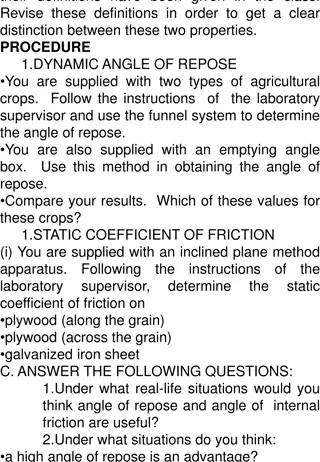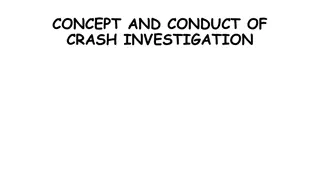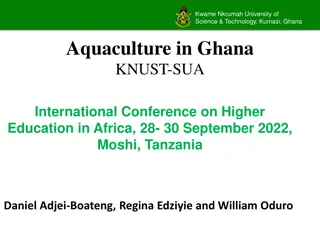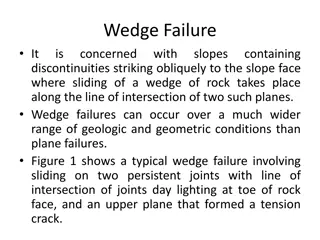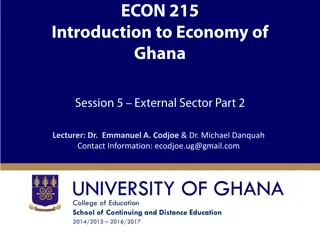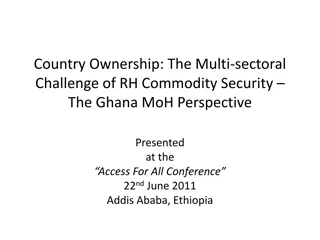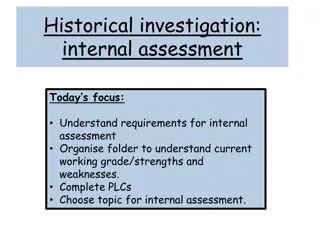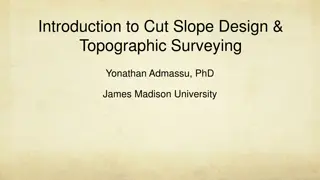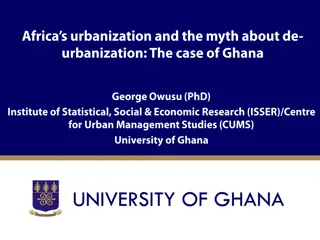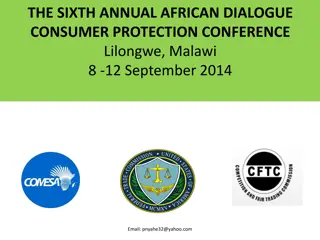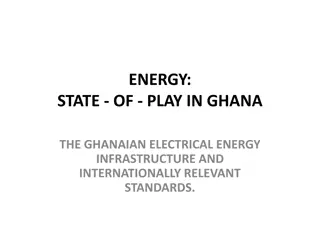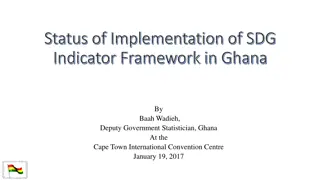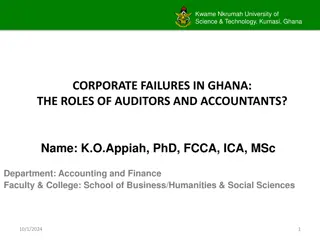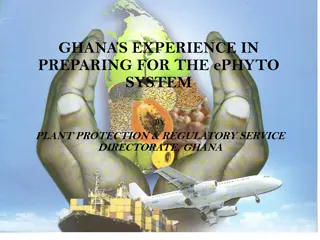Enhancing Geotechnical Investigation Methods in Ghana for Foundation Design of Large Structures
Enhancing the standard of geotechnical investigation field testing in Ghana is crucial to ensure appropriate use of equipment like DCP for designing foundations of large structures. Objectives include assessing site suitability, obtaining design inputs, anticipating construction challenges, and estimating seismic response characteristics. Key conditions to be met in geotechnical site investigations involve referencing standards, full-depth coverage, energy delivery for testing, representative results, and correcting field measurements. Depth of investigation is critical for settlement analysis and is influenced by load magnitude, depth of load influence, and plan area geometry. Various field investigation approaches like borehole drilling, SPT testing, and geophysical methods such as seismic surveys and ERT can provide comprehensive data for informed decision-making.
Download Presentation

Please find below an Image/Link to download the presentation.
The content on the website is provided AS IS for your information and personal use only. It may not be sold, licensed, or shared on other websites without obtaining consent from the author. Download presentation by click this link. If you encounter any issues during the download, it is possible that the publisher has removed the file from their server.
E N D
Presentation Transcript
IMPROVING STANDARD OF GEOTECHNICAL INVESTIGATION FIELD TESTING IN GHANA CASE OF INAPPROPRIATE USE OF DCP TEST EQUIPMENT FOR GEOTECHNICAL INVESTIGATIONS FOR DESIGN OF FOUNDATIONS OF LARGE STRUCTURES
OBJECTIVES OF GEOTECHNICAL SITE INVESTIGATIONS Assess Suitability of site (soil profile, soil material properties, ground strength trends, settlement potential, geohazards, groundwater) Obtain Design inputs (soil bearing capacity, geotechnical parameters) Anticipate Potential Construction challenges Estimate Seismic response characteristics ( critical for high-rise structures) liquefaction potential, ground frequencies, etc
GEOTECHNICAL SITE INVESTIGATION- CONDITIONS THAT MUST BE MET CONDITIONS THAT MUST BE MET 1. The Reference Standards for both Field Investigation and Laboratory testing must be clearly stated as part of the methodology. 2. Investigation must cover full depth of foundation influence zone (except in bedrock). 3. Test equipment must deliver sufficient energy to penetrate full depth of foundation influence zone. 4. Results must be representative of the whole area of interest. 5. Field measurements must be corrected to account for energy losses (hammer efficiency, rod length, overburden pressure, etc). Most important factor is the Hammer Efficiency!!
DEPTH OF INVESTIGATION Critical for settlement analysis Influenced by: Magnitude of applied load Depth of influence of imposed load below depth at which the load is applied Geometry of the plan area of stressed area
DEPTH OF INVESTIGATION- Eurocode 7 Appendix B
DEPTH OF INVESTIGATION- Eurocode 7 Appendix B
TYPICAL FIELD INVESTIGATION APPROACHES GEOTECHNICAL borehole drilling, SPT, & sampling ) Pit excavation, PLT, sampling Dynamic probing, window sampling CPT GEOPHYSICAL Seismic (refraction/reflection), MASW, HVSR ERT A combination of the 2 approaches tends to provide more comprehensive and representative data.
STANDARD PENETRATION TEST (SPT); STANDARD PENETRATION TEST (SPT); BS EN ISO 22476 PART 3: 2005 BS EN ISO 22476 PART 3: 2005 THE MOST UNIVERSALLY ACCEPTED GEOTECH FIELD TEST PROCEDURE FOR ASSESSING GROUND STRENGTH CONDITIONS FOR STRUCTURAL FOUNDATIONS ESPECIALLY IN GRANULAR MATERIAL WITH SIGNIFICANT CONTENT OF SANDS AND GRAVELS (ie STANDARD PRACTICE ). HIGH HAMMER DRIVING ENERGY (238 kJ/m2) ENABLES DEEP PERCUSSIVE PENETRATION INTO MOST TYPES OF SOIL FORMATIONS TYPICALLY ENCOUNTERED WITHIN SHALLOW FOUNDATION INFLUENCE DEPTH ZONE (1m to 15m). ANCILLARY TOOLS ENABLE PASSAGE THROUGH VERY HARD/DENSE FORMATIONS LOTS OF GEOTECHNICAL CORRELATIONS BASED ON SPT-N60 CONCEPT OF PENETRATION TEST REFUSAL BASED ON SPT HAMMER ENERGY NOT BEING ABLE TO CAUSE ADDITIONAL MEASURABLE PENETRATION. (ACCURATE INDICATION OF HIGH BEARING STRENGTH)
DYNAMIC PROBING FOR FOUNDATION INVESTIGATION DYNAMIC PROBING FOR FOUNDATION INVESTIGATION BS EN ISO 22476 BS EN ISO 22476- -2: 2005 2: 2005 Geotechnical investigation and testing-Field testing- Part 2: Dynamic probing Describes 4 procedures differentiated primarily by hammer weights (DPL, DPM, DPH, DPSH). The basis for the selection of which type is to be used should be that the driving energy (hammer mass and height of fall) is appropriate for the ground conditions anticipated. Results may be used in combination with in-situ sampling (window sampler) for qualitative determination of soil profile. Results may be used for determination of strength and deformation properties of soils through appropriate correlations. Geotechnical and equipment related factors can influence the operation of equipment and results of the test.
DIMENSIONS FOR 4 TYPES OF DYNAMIC PROBING APPARATUS (ref; BS EN ISO 22476-2: 2005) Dynamic Probing Apparatus Units DPL DPM DPH DPSH-B Hammer mass kg 10 0.1 30 0.3 50 0.5 63.5 0.5 Height of fall mm 500 10 500 100 500 10 750 20 Anvil & guide rod mass kg 6 18 18 30 Cone angle Cone base area (A) Cone base dia (min) deg cm2 mm 90 10 35.7 90 15 43.7 90 16 43.7 90 20 450.5 Drive rod mass Drive rod dia Kg/m mm 3 22 6 6 32 8 32 35 kJ/m2 Specific work/blow En=mgh/A =Etheo/A 50 100 167 238
EVALUATION OF DYNAMIC PROBING RESULTS EVALUATION OF DYNAMIC PROBING RESULTS Because of hammer fall energy losses, it is recommended to know by calibration, the actual energy transmitted to the drive rods (Etheo) when this test is used for quantitative evaluation purposes. Consideration shall be given to the influence of rod friction by side adhesion and rod bending on the recorded test values. The dynamic point resistance (qd)may be determined for quantitative interpretation of the results.
BASIC DESCRIPTION OF DCP DROP WEIGHT: 8KG ANVIL & GUIDE ROD WEIGHT: 6KG DROP HEIGHT: 575MM MAX ENERGY: 46 J ROD DIA: 20MM CONE ANGLE: 60 DEG EFFECTIVE INVESTIGATION DEPTH: 800MM MAX INVESTIGATION DEPTH: 1500MM PRIMARY USE: ASSESSMENT OF IN-SITU STRENGTH OF FLEXIBLE PAVEMENTS MADE OF UNBOUND MATERIALS
DCP-DPL COMPARISON Devic e Hammer mass (kg) Drop ht (mm) Cone area (cm2) Cone dia (mm) Rod dia (mm) Specific work/blow (kJ/m2) DCP 8 575 5 20 16 92 DPL 10 500 10 35.7 22 50 DPL cone area = 2 x DCP cone area DCP side friction >>> DPL greater energy losses
LIMITATIONS OF DCP (Annex D) 1. The low driving energy (theoretical maximum of 92kJ/m2), is not able to penetrate dense soil strata including formations containing pockets of sandy gravel or decomposed rocks even at shallow depth inability to detect underlying weak zones. 2. There are significant energy losses to side friction due to extremely small clearance around drive rods. Increasing blow count after 1m depth will not be directly attributable to increasing formation density.
LIMITATIONS OF DCP 4. Cumulative energy losses from inertia (total probe weight), hammer efficiency, and side friction, restrict DCP from effectively testing the full depth of the influence zone for a typical pad footing (eg. w=1.2m) placed at a shallow depth of 1.0m (di= 4m). 5. Limited penetration depth prevents detection of underlying weak zones typically between 2m to 4m depth. The overall effect is that the DCP test is not able to accurately generate information about the ground strength conditions of soil formations below 2m penetration depth.
Observations from DCP reports 2-3pts and 1 test pit typically used for investigations for buildings from 3-storeys to 6-storeys. Typical probing depths mainly between 0.5 and 1.5m. Typical pit depths between 1 and 1.2m. Typically high bearing capacities assigned to shallow depths (0.5-1.2m) mainly in gravelly sand/sandy clay. Photographs always of DCP but details of equipment dimensions mainly a mix of DCP & DPL dimensions. Bearing Capacity calculations based 2 formulae Qult=30r or Qall=30r
Issue 1: BC FORMULA: Qall=30r ?2? ?? ?+?[daN/cm2] or bar Dutch formula: ??= m(kg), P(kg), H(cm), A(cm2), e(10cm/blow) Commonly quoted derivation ??= ? Valid if (A= .0005m2, m=10kg, H=0.5m, , m+P=16 kg,) Problem!!! Units not consistent with reference formula. mDPL=10kg, HDPL=0.5m, ADCP=0.0005m2 ?2? ?? ?+?= 6250 = 6250 = 625r 10 ? ?????=?? 20= 625? 20= 31.3r 30r(kPa) ???
Issue 2: CUMMULATIVE EFFECT OF ROD WEIGHTS Depth (m) Rod wt (kg) M+P (kg) RD BCall 1 3 16 625r 30r 2 6 19 526r 26r 3 9 21 476r 24r
Allowable BC: Qa=30r ISSUES THAT CONTRIBUTE ERRORS The simplified formula does not address the issue of the units for drop height and cone area clearly. Although the DCP device is used for field testing the calculations are typically based on DPL dimensions (some input figures do not reflect actual equipment used). The weight effects of additional rods are not factored into computation as probing depth increases. Field measurements are not corrected for energy transfer losses and friction losses. Typical energy transfer ratios range between 0.4 and 0.6, mainly dependent on hammer release mechanism and consistency of blows/min. DCP release is manual. The overall effect is a gross over-estimation of the soil resistance.
TEST RESULTS INTERPRETATION USING DYNAMIC TEST RESULTS INTERPRETATION USING DYNAMIC RESISTANCE RESISTANCE (REF: BS EN ISO 22476 (REF: BS EN ISO 22476- -2:2005 2:2005- - ANNEX E) ANNEX E) Unit resistance ??=????? =?? ??, [Pa] ? ?+??+?? ?? Dynamic resistance ??= ?? ?2? ?? 1 ??= [Pa] --- Dutch formula ?+??+?? ??(kg) =Mass of anvil & guide rod ??(kg) =Total mass of rods A (?2) = Cone base area m (kg)=Mass of Hammer g (m/?2)=Accn due to gravity h (m)=Height of hammer fall e(blows/m) penetration rate Allowable soil pressure ??=?? (FS = 4) (Sanglaret) 20
SAMPLE DATA: Dutch Formula vrs Qa=30r (kPa) Depth (m) N-10 Dutch (kPa) Qa=30r (kPa) 10 7 90 210 20 15 193 450 30 15 193 450 40 21 271 630 50 21 271 630 60 31 400 930 70 34 438 1020 80 40 516 1200 90 37 477 1110 100 34 438 1020 110 27 348 810 120 21 271 630 130 24 309 720 140 29 374 870 150 38 490 1140 160 43 554 1290 170 50 644 1500
IMPLICATIONS OF ERRONEOUS FIELD RESULTS Over-estimation of bearing strength of resistant soil layers. Masking of presence of weak zones beneath more resistant upper strata. Termination of investigation without penetrating depth of foundation influence zone. Erroneous basis for applying geotechnical correlations.
CONCLUSIONS 1. Results from the lightweight (8kg) DCP test apparatus are typically exaggerated at depth because of high energy losses that diminish the impact energy of hammer system. Results from below 2m depth are significantly affected and therefore are not representative of the true state of affairs. Continued deployment of DCP equipment as a primary tool for geotechnical field investigations is undermining efforts to attract investments in standard geotech investigation equipment to improve indigenous capacity for proper investigations. The use of the DCP test equipment as the primary field testing device for foundation geotechnical investigations should be discouraged. 2. 3.
WAY FORWARD The GhIE should collaborate with Eng Council (& Ghana Standards Authority) to ensure the ff: 1. Prohibit the use of the DCP test equipment for geotechnical site investigations for buildings that require building permit approval. 2. Register every ground investigation test rig and conduct of energy calibration tests to determine hammer energy efficiency factor specific to each rig. 3. Register and certify all laboratories offering engineering soil testing and construction quality control services in support of geotechnical investigations.
WAY FORWARD 4. GhIE should develop standard guidelines for timely review of geotech investigation reports that also ensure the traceability of the field equipment, and the testing laboratory. 5. All Engineers who sign geotechnical investigation reports should be required to have professional indemnity insurance cover. 5. Engineers who are staff of the MMDA development (building) permit approval system (District Planning Authority) should be prohibited from engaging in provision of geotechnical investigation services in any MMDA jurisdiction (Conflict of Interest situation).


